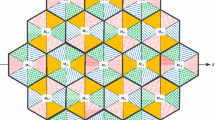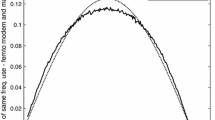Abstract
With the introduction of third generation mobile services, femtocells are considered as an economically feasible solution for combining mobile and internet technologies, thereby giving fast and reliable access to data with a better coverage. However, it is well-known that the femtocells and macrocells sharing the same licensed frequency spectrum results in heavy cross-tier interference which degrades the downlink performance considerably. In this paper, we investigate a novel frequency–division duplex allocation strategy which eliminates the downlink cross-tier interference to the femtocell network from the macrocell base station throughout its coverage area. The proposed scheme seamlessly embed the femtocells within a macrocell resource network to create a heterogeneous two-tier system. It makes use of a cross-tier complementary spectrum sharing technique known as reverse frequency allocation (RFA) where the frequency carriers used in the macrocell transmission are reversed and allocated to femtocells. As a result, it better balances the requirement of greater inter-cell orthogonality and reduced inter-cell interference since macrocell and femtocell operates on different bands in uplink and downlink. It also assures enhanced spectral efficiency and the well-known benefit of reduced outage probability, especially for cell-edge users. This work further analytically quantifies and highlights through simulation results that RFA guarantees greater overall network throughput in the downlink and reduced cross-tier interference regardless of the positioning of the femtocell with respect to the macrocell base station. Also it is to be noted that, with recent academic surveys illuminating that the benefit of femtocells is reflected more in downlink, the focus of the current work is on downlink transmission where the traffic is high and the deployment is more beneficial.








Similar content being viewed by others
References
Yavuz, M., Meshkati, F., Nanda, S., Pokhariyal, A., Johnson, N., Roghothaman, B., & Richardson, A. (2009). Interference management and performance analysis of UMTS/HSPA+ femtocells. IEEE Communications Magazine, 47(9), 102–109.
Bendlin, R., Chandrasekhar, V., Chen, R., Ekpenyong, A., & Onggosanusi, E. (2011). From homogeneous to heterogeneous networks: A 3GPP long term evolution Rel. 8/9 case study. In Proceedings of Conference on Information Sciences and Systems (pp. 1–5).
Han-Shin, J., Cheol, M., Moon, J., & Jong-Gwan, Y. (2009). Interference mitigation using uplink power control for two tier femtocell networks. IEEE Transactions on Wireless Communications, 8(10), 4906–4910.
Zahir, T., Arshad, K., Ko, Y., & Moessner, K. (2011). A downlink power control scheme for interference avoidance in femtocells. In Proceedings of 7th International Wireless Communication and Mobile Computing Conference (IWCMC) (pp. 1222–1226).
Qinliang, S., Aiping, H., Zhouyun, W., Guanding, Y., Zhaoyang, Z., Kai, X., & Y. Jin (2009). A distributed dynamic spectrum access and power allocation algorithm for femtocell networks. In Proceedings of International Conference on Wireless Communication and Signal Processing (pp. 1–5).
Jacob, P., & Madhukumar, A. S. (2011). Femto-relays: A power efficient coverage extension mechanism for femtocells. In Proceedings of IEEE 22nd International Symposium on Personal, Indoor and Mobile Radio Communications (pp. 975–979).
Choi, B. G., Cho, E. S., Chung, M. Y., Cheon, K.-Y., & Park, A.-S. (2011). A femtocell power control scheme to mitigate interference using listening TDD frame. In Proceedings of International Conference on Information Networking (ICOIN) (pp. 241–244).
Chandrasekhar, V., Andrews, J. G., & Gatherer, A. (2008). Femtocell networks: A survey. IEEE Communications Magazine, 46(9), 59–67.
Madkour, M. F., Gupta, S. C., & Wang, Y. P. E. (2002). Successive interference cancellation algorithms for downlink W-CDMA communications. IEEE Transactions on Wireless Communications, 1(1), 169–177.
Claussen, H., Ho, L., & Samuel, L. (2008). An overview of the femtocell concept. Bell Labs Technical Journal, 13(1), 221–245.
Tu, S.-Y., Chen, K.-C., & Prasad, R. (2007). Spectrum sensing of OFDMA systems for cognitive radios. In Proceedings of IEEE International Symposium on Personal Indoor and Mobile Radio Communications (PIMRC) (pp. 1–5).
Kim, T. H., & Lee, T. J. (2007). Spectrum allocation algorithms for uplink sub-carriers in OFDMA-based cognitive radio networks. In Proceedings of 4th International Conference on Innovations in Information Technology (pp. 51–54).
López-Pérez, D., Valcarce, A., de la Roche, G., & Zhang, J. (2009). OFDMA femtocells: A roadmap on interference avoidance. IEEE Communications Magazine, 47(9), 41–48.
Jabbari, B., Pickholtz, R., & Norton, M. (2010). Dynamic spectrum access and management [Dynamic spectrum management]. IEEE Wireless Communication, 17(4), 6–15.
Zhao, Q., & Sadler, B. M. (2007). A survey of dynamic spectrum access. IEEE Signal Processing Magazine, 24(3), 79–89.
Buddhikot, M. M., & Ryan, K. (2005). Spectrum management in coordinated dynamic spectrum access based cellular networks. In Proceedings of IEEE International Symposium on New Frontiers in Dynamic Spectrum Access Networks (pp. 299–307).
Ojanpera, T., & Prasad, R. (1998). An overview of third-generation wireless personal communications: A European perspective. IEEE Personal Communications, 5(6), 59–65.
Leaves, P., Moessner, K., Tafazolli, R., Grandblaise, D., Bourse, D., Tönjes, R., & Breveglieri, M. (2004). Dynamic spectrum allocation in composite reconfigurable wireless networks. IEEE Communications Magazine, 42(5), 72–81.
GPP R1-050507. (2005). Soft frequency reuse scheme for UTRAN LTE, Huawei.
Downlink inter-cell interference co-ordination/avoidance evaluation of frequency reuse. 3GPP TSG-RAN WG1 Contribution, Tech. Rep. R1-061374, May 2006. [Online]. http://www.3gpp.org/ftp/tsg_ran/WG1_RL1/TSGR1_45/Docs/R1-061374.zip
Wang, H., & Hong, D. (2009). Capacity enhancement using reversed-pair TDD frame in OFDMA femto-cell systems. In Proceedings of IEEE 70th Vehicular Technology Conference (pp. 1–5).
Pantisano, F., Ghaboosi, K., Bennis, M., & Latva-Aho, M. (2010). Interference avoidance via resource scheduling in TDD underlay femtocells. In Proceedings of IEEE Personal, Indoor and Mobile Radio Communication Workshops (PIMRC Workshops) (pp. 175–179).
de Lima, C. H. M., Bennis, M., Ghaboosi, K., & Latva-aho, M. (2010). Interference management for self-organized femtocells towards green networks. In Proceedings of IEEE Personal, Indoor and Mobile Radio Communications Workshops (PIMRC Workshops) (pp. 352–356).
Poongup, L., Taeyoung, L., Jangkeun, J., & Jitae, S. (2010). Interference management in LTE femtocell systems using fractional frequency reuse. In Proceedings of 12th International Conference on Advanced Communication Technology (Vol. 2, pp. 1047–1051).
Fujii, H., & Yoshino, H. (2008). Theoretical capacity and outage rate of OFDMA cellular system with fractional frequency reuse. In Proceedings of IEEE Vehicular Technology Conference (pp. 1676–1680).
Chang, C.-W. W., & Chien-Yuan, C. H. U. (2011). A high capacity cell architecture based on distributed antenna system and frequency allocation scheme. IEICE Transactions on Communications, 94(9), 2690–2695.
Zhang, J., Zhang, R., Li, G., & Hanzo, L. (2013). Distributed antenna systems in fractional–frequency–reuse–aided cellular networks. IEEE Transactions on Vehicular Technology, 62(3), 1340–1349.
Kim, T., & Lee, T. (2008). Throughput enhancement of macro and femto networks by frequency reuse and pilot sensing. In Proceedings of IEEE International Performance, Computing and Communication Conference (IPCCC) (pp. 390–394).
Stoyan, D., Kendall, W., & Mecke, J. (1996). Stochastic geometry and its applicataion (2nd ed.). New York: Wiley.
WINNER II WP1: WINNER II Part 1 Channel Models. IST-4-027756, D1.1.2, V1.1 (2007).
Bharucha, Z., & Haas, H. (2008). The distribution of path losses for uniformly distributed nodes in a circle. Research Letters in Communications, 2008, 1–4.
Andrews, J. G., Baccelli, F., & Ganti, R. K. (2011). A tractable approach to coverage and rate in cellular networks. IEEE Transactions on Communications, 59(11), 3122–3134.
Adachi, F. (2001). Wireless past and future-evolving mobile communication systems. IEICE Transactions on Fundamentals Electronics and Communications, E84-A(1), 55–60.
Shannon, C. E. (1949). Communication in the presence of noise. In Proceedings of the Institute of Radio Engineers (Vol. 37, pp. 10–21).
Novlan, T. D., Ganti, R. K., Ghosh, A., & Andrews, J. G. (2011). Analytical evaluation of fractional frequency reuse for OFDMA cellular networks. IEEE Transactions on Wireless Communications, 10(12), 4294–4305.
Saquib, N., Hossain, E., & Kim, D. I. (2013). Fractional frequency reuse for interference management in LTE: Advanced HetNets. IEEE Wireless Communications, 20(2), 113–122.
GPP TS 25.104 V8.10.0, Base Station radio transmission and reception (FDD) (2010).
Jacob, P., James, A., & Madhukumar, A. S. (2012). Downlink capacity improvement and interference reduction through reverse frequency allocation. In Proceedings of IEEE International Conference on Communication Systems (ICCS) (pp. 329–333).
Acknowledgments
This work was supported by Agency for Science, Technology and Research (A*STAR), Singapore under A*STAR-NIH joint Grant (SERC Grant No. 1120303045).
Author information
Authors and Affiliations
Corresponding author
Rights and permissions
About this article
Cite this article
Jacob, P., James, A. & Madhukumar, A.S. Interference mitigation through reverse frequency allocation in multi-tier cellular network: a downlink perspective. Wireless Netw 21, 1613–1629 (2015). https://doi.org/10.1007/s11276-014-0868-x
Published:
Issue Date:
DOI: https://doi.org/10.1007/s11276-014-0868-x




